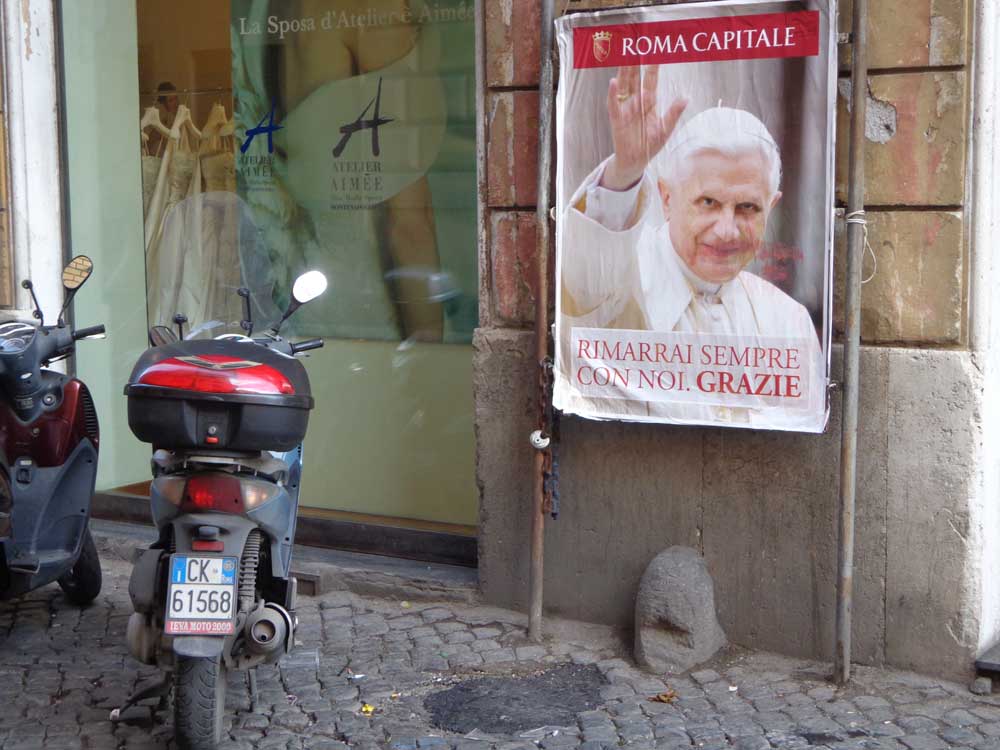Theologian in Residence


By Cornelius Sullivan
After his abdication as Supreme Pontiff of the Roman Catholic Church Cardinal Ratzinger will continue to be what he has always been, Theologian in Residence. He has realized that he can no longer be a visible apostle.
Not yet a Bishop or Cardinal, looking like the actor James Dean, Father Joseph Ratzinger was a young behind the scenes theological adviser even before the Second Vatican Council began.
Last Thursday Pope Benedict reminisced about those time speaking to the clergy of
Benedict has been the preeminent theologian serving the Church ever since.
My list of enduring contributions begins with Benedict’s emphasis on the importance of beauty. I often quote his one short sentence that is so big, “The only really effective apologia for Christianity comes down to two arguments, namely, the saints the Church has produced and the art which has grown in her womb.” 1.
Benedict, the scholar, does not mention the Church’s academic tradition, he points out two realities were the Faith is en-fleshed and that inspire pilgrimages, to
Theologian Hans Urs von Balthasar spoke of beauty in a way similar to Benedict when he said, “Our situation today shows that beauty demands for itself at least as much courage and decision as do truth and goodness, and she will not allow herself to be separated and banned from her two sisters without taking them along with herself in an act of mysterious vengeance. We can be sure that whoever sneers at her name as if she were the ornament of a bourgeois past — whether he admits it or not — can no longer pray and soon will no longer be able to love.” 2.
About sacred art and linking the trinity of beauty, truth, and goodness, that link that Balthasar and Benedict understand, John Saward said, “Robbed of sacred art, the Christian can become blind to the beauty of Divine Revelation. And that is disastrous, for, when sundered from beauty, truth becomes correctness without splendor and goodness a value of no delight.” 3.
Benedict has written eloquently and repeatedly about the importance of Sacred Art, Sacred Music, and reverent liturgy.
Secondly, I have noticed that Pope Benedict has developed what I call a “Theology of the Face”, (not analogous to Pope John Paul II’s Theology of the Body, a collection of thematically linked writings from many years), but a theme that Benedict has embraced and spoken about repeatedly, the face of God. That phrase has now become a part of the Mass. A journalist has written, “(Pope) Benedict explained that Dante’s Divine Comedy had inspired him to write his first encyclical on love. (Deus Caritas Est) In the inner light of Dante’s paradise, we do not encounter a still brighter light, but instead the gentle face of a human being: the face of Jesus Christ. The fact that God has a “human face” is the moving climax of Dante’s journey from hell to paradise. 4.
And Benedict has made pilgrimages to
Benedict’s Theology of the Face is in tune with his idea that the revitalization of the Faith should be a personal relationship with Jesus Christ and not a philosophical system or an institutional advancement. It is not unrelated to John Paul’s Theology of the Body in that both have to do with the dignity of the human person, and that both are in opposition to the materialism of Enlightenment philosophy, and to the idea that truth is relative.
Another theme of Benedict’s reign has been his assertion of the compatibility of Faith and Reason and of his recognition of the tyranny of relativism.
Reverend Martin Luther King Jr. was asked by his fellow Black Ministers how he chose which laws to break for righteousness. He said the ones that violate natural law. The Catholic Church has been the consistent voice, supported by natural law, in opposition to Enlightenment’s materialistic attacks on the value of the individual human person.
Another legacy of Pope Benedict, that is ongoing and is still developing, involves the fruits of his trip to
We have seen Pope Benedict’s joy and he has many times surprised the world with his boldness. Viva Benedetto.
1. The Ratzinger Report Messori, 1988.
2. Hans Urs von Balthasar , The Glory of the Lord: A Theological
Aesthetics: Seeing the Form, #1, 1982.
3. John Saward, The Beauty of Holiness and the Holiness of Beauty, Ignatius Press 1997.
4. Paul Badde, Inside the Vatican Magazine, March, 2006, page 8.